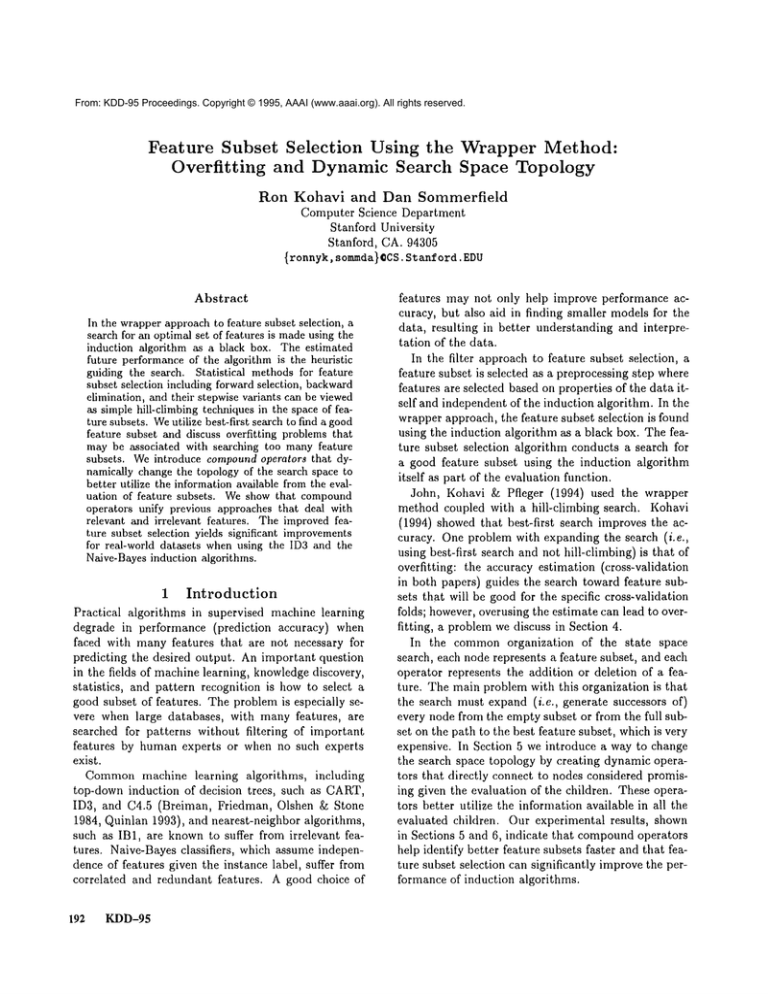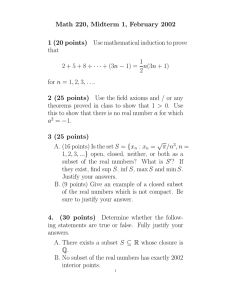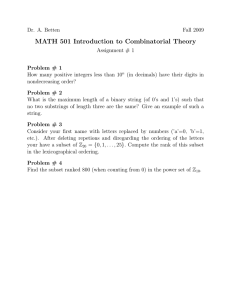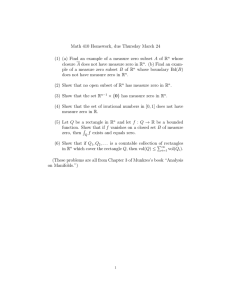
From: KDD-95 Proceedings. Copyright © 1995, AAAI (www.aaai.org). All rights reserved.
Feature Subset Selection
Using the Wrapper Method:
Overfitting
and Dynamic Search Space Topology
Ron
Kohavi
and Dan Sommerfield
Computer Science Department
Stanford University
Stanford, CA. 94305
{ronnyk, sommda}©CS.
St axtf ord. EDU
Abstract
In the wrapperapproachto feature subset selection, a
search for an optimal set of features is madeusing the
induction algorithm as a black box. The estimated
future performanceof the algorithm is the heuristic
guiding the search. Statistical methodsfor feature
subset selection including forward selection, backward
elimination, and their stepwise variants can be viewed
as simple hill-climbing techniquesin the space of feature subsets. Weutilize best-first search to find a good
feature subset and discuss overfitting problemsthat
maybe associated with searching too manyfeature
subsets. Weintroduce compoundoperators that dynamically change the topology of the search space to
better utilize the informationavailable from the evaluation of feature subsets. Weshow that compound
operators unify previous approaches that deal with
relevant and irrelevant features. The improvedfeature subset selection yields significant improvements
for real-world datasets whenusing the ID3 and the
Naive-Bayesinduction algorithms.
1 Introduction
Practical algorithms in supervised machine learning
degrade in performance (prediction accuracy) when
faced with many features that are not necessary for
predicting the desired output. An important question
in the fields of machinelearning, knowledgediscovery,
statistics,
and pattern recognition is howto select a
good subset of features. The problem is especially severe when large databases, with many features, are
searched for patterns without filtering of important
features by human experts or when no such experts
exist.
Commonmachine learning algorithms, including
top-down induction of decision trees, such as CART,
ID3, and C4.5 (Breiman, Friedman, Olshen g~ Stone
1984, Quinlan 1993), and nearest-neighbor algorithms,
such as IB1, are knownto suffer from irrelevant features. Naive-Bayes classifiers,
which assume independence of features given the instance label, suffer from
correlated and redundant features. A good choice of
192
KDD-95
features may not only help improve performance accuracy, but also aid in finding smaller models for the
data, resulting in better understanding and interpretation of the data.
In the filter approach to feature subset selection, a
feature subset is selected as a preprocessing step where
features are selected based on properties of the data itself and independent of the induction algorithm. In the
wrapper approach, the feature subset selection is found
using the induction algorithm as a black box. The feature subset selection algorithm conducts a search for
a good feature subset using the induction algorithm
itself as part of the evaluation function.
John, Kohavi & Pfleger (1994) used the wrapper
method coupled with a hill-climbing search. Kohavi
(1994) showedthat best-first search improves the accuracy. One problem with expanding the search (i.e.,
using best-first search and not hill-climbing) is that of
overfitting: the accuracy estimation (cross-validation
in both papers) guides the search toward feature subsets that will be good for the specific cross-validation
folds; however,overusing the estimate can lead to overfitting, a problemwe discuss in Section 4.
In the commonorganization
of the state space
search, each node represents a feature subset, and each
operator represents the addition or deletion of a feature. The main problem with this organization is that
the search must expand (i.e., generate successors of)
every node from the empty subset or from the full subset on the path to the best feature subset, which is very
expensive. In Section 5 we introduce a way to change
the search space topology by creating dynamic operators that directly connect to nodes considered promising given the evaluation of the children. These operators better utilize the information available in all the
evaluated children. Our experimental results, shown
in Sections 5 and 6, indicate that compoundoperators
help identify better feature subsets faster and that feature subset selection can significantly improvethe performance of induction algorithms.
2 Relevant
and
Optimal
Features
The input to a supervised learning algorithm is a training set D of m labelled instances independently and
identically distributed (i.i.d.) from an unknowndistribution ~D over the labelled instance space. An unlabelled instance X is an element of the set F1 x F2 x
¯ -- x Fn, where Fi is the domainof the ith feature. Labelled instances are tuples (X, Y) where Y is the label,
or output.
Let Z be an induction algorithm using a hypothesis
space 7/; thus Z maps D to h E 7/ and h E 7/ maps
an unlabelled instance to a label. The prediction accuracy of a hypothesis h is the probability of correctly
classifying the label of a randomly selected instance
from the instance space according to the probability
distribution ~D. The task of the induction algorithm
is to choose a hypothesis with the highest prediction
accuracy.
Wenow define relevance of features in terms of a
Bayesclassifier--the optimal classifier for a given problem. A feature X is strongly relevant if removal of X
alone will result in performancedeterioration of an optimal Bayesclassifier. A feature X is weakly relevant if
it is not strongly relevant and there exists a subset of
features, S, such that the performance of a Bayes classifter on S is worse than the performance on SO{f}.
A feature is irrelevant if it is not strongly or weakly
relevant. The set of strongly relevant features is called
the core. Formalized versions of the above definitions
can be found in John et al. (1994).
There are three main problems with these definitions
that make them hard to use in practice. First, many
hypothesis spaces are parametric (e.g., perceptrons,
monomials) and the best hypothesis approximating the
target concept from the family maynot even use all the
strongly relevant features. Second, practical learning
algorithms are not always consistent: even with an infinite amount of data they might not converge to the
best hypothesis. Third, even consistent learning procedures maybe improved for finite samples by ignoring
relevant features. These reasons motivated us to define the optimal features, which depend not only on
the data, but also on the specific induction algorithm.
An optimal feature subset, 8", for a given induction
algorithm and a given training set is a subset of the
features, ~q°, such that the induction algorithm generates a hypothesis with the highest prediction accuracy.
The feature subset need not be unique.
The relation between relevant and optimal features
is not obvious. In Section 5, we show how compound
operators improve the search for optimal features using the ideas motivated by the above definitions of relevance.
3 Feature
Subset
Selection
as
Heuristic
Search
The statistical
and pattern recognition literature on
feature subset selection dates back a few decades, but
the research deals mostly with linear regression. We
refer the reader to the related work section in John et
al. (1994) for key references. Langley (1994) provides
a survey of recent feature subset selection algorithms,
mostly in machine learning.
Most criteria for feature subset selection from the
statistics and pattern recognition communities are algorithm independent and do not take into account the
differences between the different induction algorithms.
For example, as was shown in John et al. (1994), features with high predictive powermayimpair the overall
accuracy of the induced decision trees.
The task of finding a feature subset that satisfies a
given criteria can be described as a state space search.
Each state represents a feature subset with the given
criteria used to evaluate it. Operators determine the
partial ordering between the states.
In this paper, we use the wrapper method wherein
the criteria to optimize is the estimated prediction accuracy. Methods that wrap around the induction algorithm, such as holdout, bootstrap, and cross-validation
(Weiss & Kulikowski 1991) are used to estimate the
prediction accuracy. To conduct a search, one needs
to define the following:
Search Space Operators The operators
in the
search space are usually either "add feature" or
"delete feature" or both. In the statistics literature,
the term forward selection refers to a space containing only the "add feature" operator; the term backward elimination refers to a space containing only
the "delete feature" operator. The stepwise methods use both operators. In our experiments, we used
both operators.
Accuracy Estimation The heuristic function in the
wrapper approach is the estimated prediction accuracy. In our experiments, we used ten-fold crossvalidation as the accuracy estimation function.
Search Algorithm Any heuristic
search algorithm
can be used to conduct the search. In our experiments, we used best-first search, which at every iteration generates the successors of the the best unexpanded node (the node with the highest estimated
accuracy). The termination condition was five consecutive non-improving nodes. The initial node determines the general direction of the search. One
typically starts forward selection from the empty set
of features and backward elimination from the full
set of features.
Kohavi
193
Accuracy
Rand
8O
75
- forward
Accuracy
Breast Cancer
selection
80
/-°
65
50 ................................
i00 2003bo400 sbosdo
Nodes
Accuracy
Glass2 - backward
,
..
".
-,
\
75
"-
"
70
"
""
""
0
elimination
80
’
76
74
72
70
"
selection
/
78
60
55
- forward
20
40
60
Nodes
80
0
~’\~
20 40 60 80 I00
Nodes
Figure 1: Overfitting in feature subset selection using ID3. Theleft graph showsaccuracies for a randomdata.set. Thesolid
line represents the estimatedaccuracyfor a training set of 100instances, the thick greyline for a training set of 500instances,
and the dotted line showsthe real accuracy. The middle and right graphs showthe accuracy for real-world datasets. The
solid line is the estimated accuracyand the dotted line is the accuracyon an independenttest set.
4 Overfitting
An induction algorithm overfits the dataset if it models the given data too well and its predictions are poor.
An exampleof an over-specialized hypothesis, or classifter, is a lookup table on all the features. Overfitting
is closely related to the bias-variance tradeoff (Geman
& Bienenstock 1992, Breimanet al. 1984): if the algorithm fits the data too well, the variance term is large,
and hence the overall error is increased.
Most accuracy estimation methods, including crossvalidation, evaluate the predictive powerof a given hypothesis over a feature subset by setting aside instances
(holdout sets) that are not shownto the induction algorithm and using them to assess the predictive ability
of the induced hypothesis. A search algorithm that explores a large portion of the space and that is guided by
the accuracy estimates can choose a bad feature subset: a subset with a high accuracy estimate but poor
predictive power.
If the search for the feature subset is viewedas part
of the induction algorithm, then overuse of the accuracy estimates may cause overfitting in the featuresubset space. Because there are so manyfeature subsets, it is likely that one of themleads to a hypothesis
that has high predictive accuracy for the holdout sets.
A good example of overfitting can be shown using a
no-information dataset (Rand) where the features and
the label are completely random. Figure 1 (left) shows
the estimated accuracy versus the true accuracy for
the best node the search has found after expanding k
nodes. One can see that especially for the small sample
of size 100, the estimate is extremely poor (26%optimistic), indicative of overfitting. The middle and right
graphs in the figure showoverfitting in small real-world
datasets.
Recently, a few machine learning researchers have
reported the cross-validation estimates that were used
to guide the search as a final estimate of performance,
thus achieving overly optimistic results. Experiments
194
KDD-95
using cross-validation to guide the search must report
the accuracy of the selected feature subset on a separate test set or on holdout sets generated by an external
loop of cross-validation that were never used during the
feature subset selection process.
The problem of overfitting in feature subset space
has been previously raised in the machine learning
communityby Wolpert (1992) and Schaffer (1993),
the subject has received muchattention in the statistics community(cf. Miller (1990)).
Although the theoretical problem exists, our experiments indicate that overfitting is mainly a problem
when the number of instances is small. For our experiments, we chose reasonably large datasets and our
accuracies are estimated on unseen instances. In our
reported experiments, there were 70 searches for feature subsets. Ten searches were optimistically biased
by more than two standard deviations and one was
pessimistically biased by more than two standard deviations.
5 Compound
Operators
In this section we introduce compound operators, a
method that utilizes the accuracy estimation computed
for the children of a node to change the topology of the
search space.
The motivation for compoundoperators comes from
Figure 2 that partitions the feature subsets into core
features (strongly relevant), weakly relevant features,
and irrelevant features. An optimal feature subset for
a hypothesis space must be from the relevant feature
subset (strongly and weakly relevant features). A backward elimination search starting from the full set of
features (as depicted in Figure 2) that removes one
feature at a time, will have to expand all the children
of each node before removinga single feature. If there
are i irrelevant features and f features, (i ¯ f) nodes
must be evaluated. In domains where feature subset
selection might be most useful, there are manyfeatures
real1
ic,ac
aus]:rallan - backward elimination
-IJ’-
"
86}
/ ./f~"
.....
l"
I
84
real acc
crx - backward elimination
81[ /,."/"
80~
"
50
100 150 200 250 300
Nodes
~6
~ea~-large
- forward
selection
.*-’
t/( .o
166 260 360 4~°des 2of
i00
200 300
400
Nodes
Figure 3: Comparisonof compound(dotted line) and non-compound
(solid line) searches. The accuracy (y-axis) is that
the best node on an independenttest set Mter a given numberof node evaluations (x-axis).
Nofeatures
yealdy
am ¢ithersiongly~levant~
’:~
D¢2
)ll////
or weakly relevmat
All feaures
Figure 2: The state space. If a feature subset contMn.q
an irrelevant feature, it is in the irrelevant area; if it conrains onlystronglyrelevant features it is in-the core region;
otherwise, it is in the relevant region. The dotted arrows
indicate compoundoperators.
but such a search may be prohibitively expensive.
Compoundoperators are operators that are dynamically created after the standard set of children, created
by the add and delete operators, have been evaluated.
Intuitively, there is more information in the evaluation
of the children than just the node with the maximum
evaluation. Compoundoperators combine operators
that led to the best children into a single dynamicoperator. If we rank the operators by the estimated accuracy of the children, then we can define compound
operator ci to be the combination of the best i + 1 operators. For example, the first compoundoperator will
combine the best two operators.
The compoundoperators are applied to the parent,
thus creating children nodes that are farther away in
the state space. Each compound node is evaluated
and the generation of compound operators continues
as long as the estimated accuracy of the compound
nodes improves.
Compoundoperators generalize a few suggestions
previously made. Kohavi (1994) suggested that the
search might start from the set of strongly relevant
features (the core). If one starts from the full set
features, removal of any single strongly relevant feature will cause a degradation in performance, while removal of any irrelevant or weaklyrelevant feature will
not. Since the last compoundoperator connects the
full feature subset to the core, the compoundoperators from the full feature subset plot a path leading to
the core. The path is explored by removing one feature
at a time until estimated accuracy deteriorates. Caruana ~ Freitag (1994) implemented a SLASHversion
of feature subset selection that eliminates the features
not used in the derived decision tree. If there are no
features that improve the performance when deleted,
then (ignoring orderings due to ties) one of the compound operators will lead to the same node that slash
would take the search to. While the SLASHapproach
is only applicable for backward elimination, compound
operators are also applicable to forward selection.
In order to compare the performance of the feature
subset selection algorithm with and without compound
nodes, we ran experiments comparing them on different datasets. Figure 3 compares a search with and
without compound operators.
Compound operators
improve the search by finding nodes with higher accuracy faster; however, wheneverit is easy to overfit,
they cause overfitting earlier.
6 Experimental
Results
In order to compare the feature subset selection,
we used ID3 and Naive-Bayes, both implemented
in A//£C++ (Kohavi, John, Long, Manley & Pfleger
1994). The ID3 version does no pruning by itself;
pruning is thus achieved by the feature subset selection mechanism. The Naive-Bayes algorithm assumes
the features are independent given the instance label.
The use of feature subset selection in Naive-Bayes was
first suggested in Langley ~ Sage (1994). The data
for Naive-Bayes was discretized using the discretization algorithm presented in Fayyad & Irani (1993) and
implemented in A~LC++.
Kohavi
195
Dataset
anneal
breast (L)
chess
crx
heart
hypothyroid
pima
soybean-lrg
vote
Features
24
9
36
15
13
25
8
35
16
Train Test
sizes
898 CV-5
286 CV-5
2130 1066
690 CV-5
270 CV-5
2108 1055
768 CV-5
683 CV-5
435 CV-5
Majority
Accuracy
76.174-1.4
70.284-2.7
52.22-t-0.9
55.514-1.9
55.564-3.0
95.234-0.4
65.10=t=1.7
13.474-1.3
61.384-2.3
Dataset
australian
breast (W)
cleve
DNA
horse-colic
mushroom
sick-euthyroid
vehicle
votel
Table h Datasets and baseline accuracy (majority). CV-5 indicates
number after the 4- denotes one standard deviation of the accuracy.
Dataset
anneal
australian
breast (L)
breast (W)
chess
cleve
crx
DNA
heart
horse-colic
hypothyroid
mushroom
pima
sick-euth
soybean-lrg
vehicle
vote
votel
Average
ID3
99.554-0.2
80.434-1.0
68.204-2.9
94.42-4-0.8
98.694-0.3
71.994-3.2
79.864-1.7
90.394-0.9
72.22-t-3.0
75.324-3.8
98.584-0.4
100.004-0.0
71.754-2.1
96.494-0.6
91.944-1.0
73.764-2.0
94.024-0.4
84.60+1.2
85.68
ID3-FSS
p-val
0.23
99.334-0.2
85.944-1.7
1.00
73.434-2.3
0.92
94.284-0.8
0.45
0.65
98.874-0.3
0.94
77.874-2.0
0.97
84.354-1.6
92.504-0.8
0.97
81.484-2.8
0.99
84.794-2.0
0.99
0.65
98.774-0.3
100.004-0.0
0.50
0.18
68.364-3.0
95.83-t-0.6
0.22
93.27=t=1.3 0.80
69.864-0.9
0.04
95.634-0.8
0.97
0.87
86.444-1.2
87.83
Majority
Feat- Train Test
ures
sizes
Accuracy
690 CV-5 55.514-1.9
14
10
699 CV-5 65.524-1.8
13
303 CV-5 54.464-2.9
180 3186 2000 51.914-0.9
22
368 CV-5 63.044-2.5
22
5416 2708 51.804-0.6
25
2108 1055 90.744-0.5
18
846 CV-5 25.774-1.5
15
435 CV-5 61.384-2.3
accuracy estimation
C4.5
91.654-1.6
85.364-0.7
71.004-2.3
94.714-0.4
99.504-0.3
73.624-2.3
85.804-1.0
92.704-0.8
77.044-2.8
84.784-1.3
99.204-0.3
100.004-0.0
72.654-1.8
97.70+0.5
88.284-2.0
69.864-1.8
95.634-0.4
86.674-1.1
87.01
by 5-fold cross-validation.
Naive-Bayes
97.664-0.4
86.094-1.1
70.994-2.3
97.144-0.5
87.154-1.0
82.874-3.1
86.964-1.2
93.344-0.7
81.484-3.3
80.96=1=2.5
98.584-0.4
96.604-0.3
75.514-1.6
95.644-0.6
91.36-1-2.0
59.224-1.6
90.34=t=0.9
87.364-2.1
86.63
The
NB-FSS p-val
96.664-1.0
0.18
85.904-1.6
0.47
70.634-2.1
0.45
96.574-0.4
0.19
94.284-0.7
1.00
83.204-2.6
0.53
85.074-0.8
0.08
0.53
93.424-0.7
84.074-2.0
0.75
83.704-1.2
0.84
99.244-0.3
0.93
99.704-0.1
1.00
73.564-2.2
0.24
0.98
97.354-0.5
93.41-1-0.8 0.83
61.234-1.3
0.84
94.714-0.6
1.00
90.804-2.0
0.88
87.97
Table 2: The accuracies for ID3, ID3 with feature subset selection (FSS), C4.5, Naive-Bayes, and Naive-Bayes with FSS.
The numbers after the 4- indicate the standard deviation of the reported accuracy. The first p-val column indicates the
probability that FSS improves ID3 and the second column indicates the probability that FSS improves Naive-Bayes. The
p-values were computed using a one-tailed t-test.
Because small datasets are easier to overfit using
our approach, we chose real-world datasets from the
U.C. Irvine repository
(Murphy & Aha 1994) that had
at least 250 instances.
For datasets with over 1000
instances, a separate test set with one-third of the instances was used; for datasets
with fewer than 1000
instances,
5-fold cross-validation
was used. Table 1
describes general information about the datasets used.
The initial
node for our search was the empty set
of features mainly because the search progresses faster
and because in real-world
domains one would expect
many features to be irrelevant or weakly relevant. The
best-first
search is able to overcome small local maxima
caused by interacting
features, whereas hill-climbing
cannot.
Table 2 shows that feature
196
KDD-95
subset selection
signif-
icantly (over 90% confidence) improves ID3 on eight
out of the eighteen domains and significantly
degrades
the performance only on one domain. Performance of
Naive-Bayes significantly
improves on five domains and
significantly
degrades on one domain. The average error rate for the datasets tested decreased (relatively)
by 15% for ID3 and by 10% for Naive-Bayes.
Both
ID3 and Naive-Bayes were inferior
to C4.5, but both
outperformed C4.5 after feature subset selection.
A similar experiment (not shown) with C4.5 showed
that C4.5 with feature subset selection slightly improved C4.5: the average accuracy
went up from
87.01% to 87.60%, a 4.5% reduction in error.
The execution time on a Sparc20 for feature subset
selection using ID3 ranged from under five minutes for
breast-cancer
(Wisconsin), cleve, heart, and vote
about an hour for most data.sets. DNAtook 29 hours,
followed by chess at four hours. The DNArun took so
long because of ever increasing estimates that did not
really improve the test-set accuracy.
7 Conclusions
Wereviewed the wrapper method and discussed the
problem of overfitting when the search through the
state space is enlarged through the use of best-first
search. While overfitting can occur, the problem is
less severe for large datasets, so we have restricted our
experiments to such datasets. One possible way to deal
with overfitting is to reevaluate the best nodes using
different cross-validation folds (i.e., shuffle the data).
Initial experiments indicate that re-evaluation of the
best nodes indeed leads to lower estimates for those
nodes, partially overcomingthe overfitting problem.
Weintroduced compound operators that change the
search topology based on information available from
the evaluation of children nodes. The approach generalizes previous suggestions and was shown to speed
up discovery of good feature subsets. Our results indicated significant improvementboth for ID3 and NaiveBayes and some improvement for C4.5. The average
error rate for the datasets tested decreased (relatively)
by 15% for ID3, by 10%for Naive-Bayes, and by 4.5%
for C4.5.
An issue that has not been addressed in the literature is whether we can determine a better starting
point for the search. For example, one might start
with the feature subset used by a learning algorithm
when the subset is easy to identify, such as whenusing
decision trees.
Acknowledgments
The work in this paper was
done using the A//£g++ library, partly funded by ONR
grant N00014-94-1-0448 and NSF grants IPd-9116399
and IRI-9411306. Wethank George John and Pat Langley for their comments. The reviewers commentswere
excellent, but many are not addressed due to lack of
space.
References
Breiman, L., Friedman, J. H., Olshen, R. A. & Stone,
C. J. (1984), Classification and Regression Trees,
Wadsworth International Group.
Caruana, R. & Freitag, D. (1994), Greedy attribute
selection, in W. W. Cohen & H. Hirsh, eds, "Machine Learning: Proceedings of the Eleventh International Conference", Morgan Kaufmann.
Fayyad, U. M. & Irani, K. B. (1993), Multi-interval
discretization of continuous-valued attributes for
classification learning, in "Proceedingsof the 13th
International Joint Conference on Artificial Intelligence", Morgan Kaufmann, pp. 1022-1027.
Geman,S. & Bienenstock, E. (1992), "Neural networks
and the bias/variance dilemma", Neural Computation 4, 1-48.
John, G., Kohavi, 1%. & Pfleger, K. (1994), Irrelevant features and the subset selection problem, in
"Machine Learning: Proceedings of the Eleventh
International
Conference", Morgan Kaufmann,
pp. 121-129. Available by anonymousftp from:
starry.Stanford.
EDU:pub/ronnyk/m194,
ps.
Kohavi, R. (1994), Feature subset selection as search
with probabilistic estimates, in "AAAIFall Symposium on Relevance", pp. 122-126.
Kohavi, R., John, G., Long, R., Manley, D. &
Pfleger, K. (1994), MLC++:A machine learning library in C++, in "Tools with Artificial Intelligence", IEEE ComputerSociety Press,
pp. 740-743. Available by anonymous ftp from:
starry. Stanford. EDU: pub/ronnyk/mlc/
toolsmlc,
ps.
Langley, P. (1994), Selection of relevant features in machine learning, in "AAAIFall Symposiumon Relevance", pp. 140-144.
Langley, P. & Sage, S. (1994), Induction of selective
bayesian classifiers, in "Proceedings of the Tenth
Conference on Uncertainty in Artificial Intelligence", Morgan Kaufmann, Seattle, WA,pp. 399406.
Miller, A. J. (1990), Subset Selection in Regression,
Chapman and Hall.
Murphy, P. M. & Aha, D. W. (1994), UCI repository
machine learning databases, For information contact ml-repository@ics.uci.edu.
Quinlan, J. 1%. (1993), C~.5: Programs for Machine
Learning, Morgan Kaufmann, Los Altos, California.
Schaffer, C. (1993), "Selecting
method by cross-validation",
13(1), 135-143.
a classification
Machine Learning
Weiss, S. M. & Kulikowski, C. A. (1991), Computer
Systems that Learn, Morgan Kaufmann, San Mateo, CA.
Wolpert, D. H. (1992), "On the connection between insample testing and generalization error", Complex
Systems 6, 47-94.
Kohavi
197






